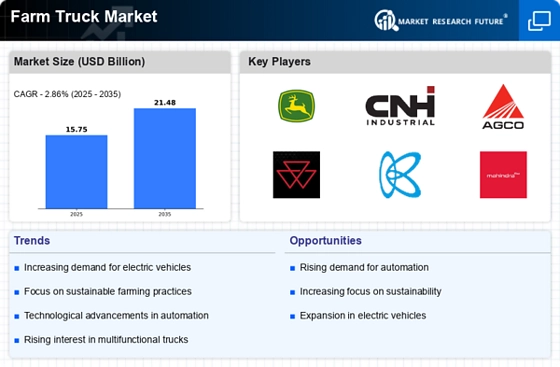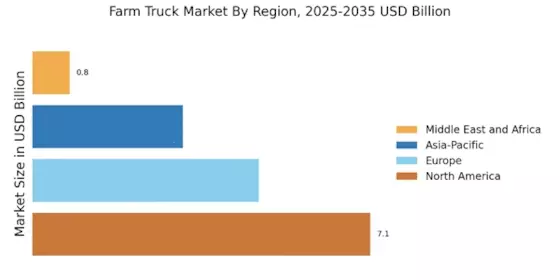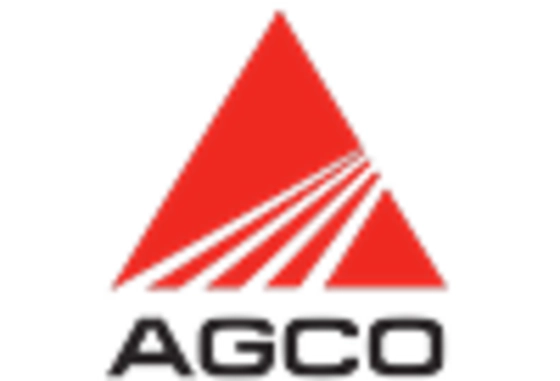Government Support and Subsidies
Government initiatives aimed at supporting the agricultural sector are significantly influencing the Farm Truck Market Industry. Various governments are implementing subsidy programs and financial assistance to encourage farmers to invest in modern farm equipment, including trucks. These initiatives are designed to enhance productivity and sustainability within the agricultural sector. For instance, funding programs may cover a portion of the costs associated with purchasing new farm trucks, thereby making them more accessible to farmers. This support not only stimulates the Farm Truck Market Industry but also promotes the adoption of advanced technologies that improve operational efficiency. As a result, the market is likely to witness an influx of new entrants and innovations, further driving growth.
Rising Demand for Agricultural Products
The Farm Truck Market Industry is experiencing a notable increase in demand for agricultural products, driven by the growing global population and the subsequent need for food production. As farmers seek to enhance their operational efficiency, the demand for farm trucks, which facilitate the transportation of goods from fields to markets, is likely to rise. According to recent data, the agricultural sector is projected to grow at a compound annual growth rate of approximately 3.5% over the next five years. This growth is expected to spur investments in farm trucks, as they play a crucial role in ensuring timely delivery and reducing spoilage of perishable goods. Consequently, the Farm Truck Market Industry is poised to benefit from this trend, as farmers increasingly rely on efficient transportation solutions to meet market demands.
Technological Innovations in Farm Trucks
Technological advancements are reshaping the Farm Truck Market Industry, as manufacturers introduce innovative features that enhance performance and efficiency. The integration of smart technologies, such as GPS tracking and telematics, allows farmers to monitor their trucks in real-time, optimizing routes and reducing fuel consumption. Additionally, advancements in electric and hybrid truck designs are gaining traction, appealing to environmentally conscious farmers. These innovations not only improve operational efficiency but also align with sustainability goals within the agricultural sector. As farmers increasingly prioritize technology-driven solutions, the Farm Truck Market Industry is likely to witness a surge in demand for trucks equipped with cutting-edge features, further driving market growth.
Increased Focus on Supply Chain Efficiency
The Farm Truck Market Industry is being propelled by an increased focus on supply chain efficiency within the agricultural sector. As farmers strive to optimize their operations, the need for reliable transportation solutions becomes paramount. Farm trucks are essential for ensuring that products reach consumers in a timely manner, thereby reducing waste and enhancing profitability. Recent studies indicate that logistics and transportation account for a significant portion of agricultural costs, prompting farmers to invest in more efficient farm trucks. This trend is likely to continue, as the industry recognizes the importance of streamlining supply chains to remain competitive. Consequently, the Farm Truck Market Industry stands to gain from this heightened emphasis on efficiency, as farmers seek to modernize their fleets.
Growing Interest in Sustainable Farming Practices
The Farm Truck Market Industry is witnessing a shift towards sustainable farming practices, which is influencing purchasing decisions among farmers. As environmental concerns become more pronounced, many farmers are seeking to adopt practices that minimize their ecological footprint. This trend includes the use of farm trucks that are designed with sustainability in mind, such as those that utilize alternative fuels or have lower emissions. Research indicates that a significant percentage of farmers are willing to invest in eco-friendly equipment, which is likely to drive demand for sustainable farm trucks. Consequently, the Farm Truck Market Industry is expected to evolve, with manufacturers focusing on developing trucks that meet the growing demand for sustainability, thereby aligning with broader agricultural trends.


















Leave a Comment